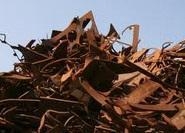Scrap Prices North America

Scrap to Move Higher in June; Chinese Buying Up Pig Iron
Written by Tim Triplett
May 26, 2020
Ferrous scrap remains in limited supply, prompting predictions that scrap prices will settle still higher in June, on top of the big increase in May. Steel Market Update sources forecast an increase of $10-20 per ton for obsolete grades and $20-30 per ton for prime grades in June from May levels. Higher scrap prices may lend support to the higher finished steel prices announced by the mills this month.
In May, ferrous scrap prices settled up $30 per ton for shred and up $40-50 per ton for busheling as coronavirus shutdowns disrupted scrap generation and collection. While demand is expected to improve next month as government restrictions ease and more manufacturers reopen, scrap supplies are likely to remain tight for a while.
“I expect the June ferrous scrap trade to resemble the May trade except prime scrap will likely be tighter as dealers will have shipped most of what they had and big manufacturing is still in the early stages of getting back to work. Demand should be a little better too,” said one dealer in the Northeast.
Obsolete flows are mediocre though improving slightly each week. Shredders are fighting over what little feedstock can be bought. Export prices are generally stable and export dock inventories remain very tight, he added.
Pig Iron Market Warning
One Steel Market Update source offers the following assessment of the global pig iron market:
“USA mills bought pig iron earlier this month for delivery in August, possibly July, at prices of about $305/MT CFR. They wanted to buy cheaper but couldn’t because of Chinese demand. This situation was happening even prior to the virus scare. The Chinese view pig iron as an economical alternative to both high domestic scrap prices and to a stubbornly high iron ore market. This is in contrast to usage in the USA, where it is used to wash down the residual alloys in the scrap to which they already have access to produce quality flat-roll in EAFs.
“The Chinese started buying South Brazilian BPI, which has a higher phos level. For the last three decades, USA mills have shunned this product in favor of northern Brazilian material, which has a lower phos level. As production in Northern Brazil was reduced by over 60 percent over the last 10 years, they became more dependent on Russian and Ukrainian producers, to the point where two-thirds of their imports came from this region.
“Now that China seems to be a confirmed regular pig iron user, and after they raided most of the South Brazilian exports, they are on their way to supplanting the USA as the largest market for Russian and Ukrainian pig iron. The USA mills are forced to match the Chinese price levels. This has caused delays in restocking USA supply lines and has forced them to succumb to pricing that is out of line with domestic scrap pricing. This has happened at least three times in the last nine months. The situation would have been much worse if the virus had not reduced USA production.
“Since the last USA pig iron booking at $305, the Chinese have purchased multiple CIS cargoes. At the price they paid, it will drive up the USA price equivalent north of $320. These buys also push out the available delivery dates. It looks like August shipment (September arrival) will be sold out very soon. The producers will increase prices further.
“This is really a dangerous situation for thin slab casters in the USA using EAFs. At this stage, there is not enough DRI or HBI to go around. There is a real possibility this can increase sheet pricing and could make imports more attractive.”

Tim Triplett
Read more from Tim TriplettLatest in Scrap Prices North America

HRC vs. scrap spread widens over $150/ton in March
The HRC vs. prime scrap spread increased again in March.

HRC vs. prime scrap spread increases in February
The price spread between hot-rolled coil (HRC) and prime scrap widened in February ahead of the implementation of President Trump’s tariffs on steel.
HRC vs. prime scrap spread narrows again in January
The price spread between hot-rolled coil (HRC) and prime scrap continued to narrow in January, according to SMU’s most recent pricing data. While SMU’s average HRC price edged down week over week (w/w), it rose compared to a month ago. The January price for busheling also increased from December. Our average HRC price as of […]

HRC vs. prime scrap spread flat in November
The price spread between hot-rolled coil (HRC) and prime scrap remained the same in November as both tags were at the levels seen a month earlier, according to SMU’s most recent pricing data.

HRC vs. busheling spread narrows slightly in October
The price spread between hot-rolled coil (HRC) and prime scrap narrowed marginally in October, according to SMU’s most recent pricing data.
